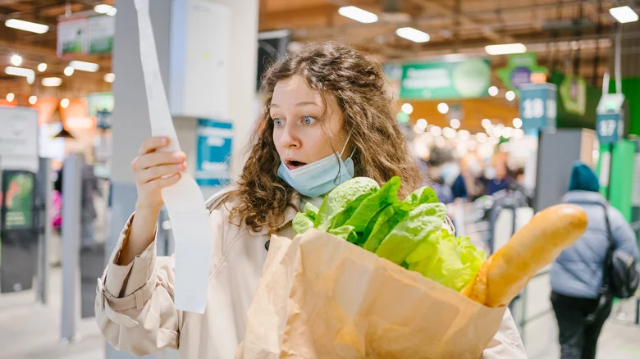I think we’ve all heard about the desperate, stupid things some folks did during Prohibition in the U.S. just to get a drink. We’re starting to hear about similar ill-advised choices folks are making to keep food on the table during the current food price storm.
 High Food Prices – simply shocking! For some, the only way to ‘cope’ is eat less.
High Food Prices – simply shocking! For some, the only way to ‘cope’ is eat less.
Or not at all… But there are other, smart ways and not-so-smart ways
to deal with soaring food prices. Just stop and think, first…
T’was ever thus…
The story goes that folks tried to counterfeit hard liquor during Prohibition by mixing up large quantities of ‘hooch’ in their bathtubs. They’d bottle it in used containers and flog it out of their wood sheds, back kitchens and car trunks. Trouble was, relatively large numbers of intrepid booze makers were unaware that some alcohol is not potable, beverage quality stuff. Particularly, methanol, which – though a cousin to ethanol, the drinkable kind – is deadly poisonous. Thus did many a bootlegging operation – and many a bootlegger – rise and fall literally a matter of hours.
The lesson in that historical nugget: Let the pros do what they do best. In the case of whiskey, millions of Americans relied on big-time smugglers such as Al Capone and Joe Kennedy to provide them with real-deal Canadian booze, the quality of which was never in doubt.
Fast forward to the COVID Crisis
Watch as conventional restaurants fall in the face of closures, isolation orders and mask rules. Watch as thousands of foodservice workers join the unemployment lines. Watch as a few conventional restos change over to order-by-phone, and receive-by-delivery operations. Watch as fast food joints make the most of this new dimension in take-out service, which fits their existing business model like a glove. Watch as food delivery services grow out of control – until governments put caps on their fees, and consumers refuse, in droves, to pay them. Watch as the traditional dynamics of the food chain go all to hell.
And watch as COVID, the war in Ukraine and global warming throw food production into an economic mix-master. Watch, ultimately, as food prices rise amid perpetual (though largely unfulfilled) threats of shortages.
The food is there – but…
More and more folks – including those who until recently considered themselves comfortably ensconced in the middle classes, are discovering they don’t have enough money each month to buy what they want to eat.
The truth is, they are feeling a squeeze initially because they are being pressed by the already high and rising prices for convenience and luxury foods they’ve taken for granted as part of their accustomed lives. Then they turn around and see the price of beef (all cuts, regardless of how prime or ‘po folks’-associated they once were) has hit and surpassed the $30 per kg level. In fact, most meat has been consigned to ‘treat’ status. Soon after beef took flight, chicken and pork followed suit. And fresh produce – perhaps the most important component of the North American food plate – just generally priced itself out of reach for many folks.
What do you do?
Some folks have looked back to the Great Depression and planted gardens, like their grand parents and great grands did. But a garden means a commitment to the work it takes to water it if need be, keep it bug- and weed-free, and to deal properly with the harvest responsibly – especially if you’re lucky enough to have a surplus. Others undertook long trips to the boonies and shopped for food at the farm gate. Alas, many found that prices at the old fashioned roadside stands were almost as high as those in the supermarkets. The cost of fuel, fertilizer and labour was driving prices up for the small operators, too. And there was no difference in overall cost once hungry shoppers took into account their own time and fuel costs.
Some explored the exotic and chancy world of supermarket dumpster diving. But that wasn’t exactly a palatable option for many average folks.
Others simply switched to no-name and house brand packaged foods. But that didn’t save them as much cash as they ultimately needed to make ends meet.
Buffet restos on the rebound
A recent report says some buffet-style restos have bounced back from ruin. Why? Folks can take themselves and their 6 kids to the open-concept, self-serve dining rooms and fill their bellies for a set price. Prices may still be on the high side, but folks can budget for their occasional indulgences. And have spaghetti (see photo, top of page), and beans and rice, and other relatively cheap but nutritious meals the rest of the week.
As happens now and then, when buffet-style restos make the news, there is a corps of nay-sayers out there – who may have a point, but, on the other other hand, may beat a little too hard on their drums. I refer to the folks who say, “I’d never eat at a place where hundreds of strangers have had their paws in the service trays!” And, “They can’t possibly control the the temperature of those buffet tables and keep them within safe limits to prevent germs from proliferating!”
First, those folks have obviously never seen what goes on behind the scenes at conventional restos. No examples here, just use your imaginations.
Second, Buffets do take advantage of lower staff costs since they don’t need to provide counter service or table service to individual diners. And they may be able to get special discounts by buying certain foods regularly, at predictable, regular volumes. But they have to pay the same as conventional restos for insurance, utilities, equipment, security, rent, and all the other costs any business must endure.
And buffets do have to meet all the health and safety constraints regular restos have to meet. And there are special, additional rules that buffets have to follow to ensure that their tables and the food on them are safe.
You decide whether you’d be happy ‘risking’ potentially ‘dangerous’ buffets. If I was so-inclined, I’d have no issues with eating at any of the big, chain buffets, such as Golden Corral.
The dark side of dollar stores
There’s a new sport that’s all the rage among lower-middle class shoppers. They’re apparently packing themselves into the dollar discount stores looking for food bargains.
Problem there is, they’re going entirely by price, and disregarding (in many cases) the Best Before and Expiry dates on the labels. Dollar stores often get cheap, packaged products by buying foods by the case (from jobbers) which were simply ‘moved out of inventory’ by conventional grocery stores. They’re not supposed to do this. It’s frowned upon by health and safety experts, though violating ‘Best Before’ constraints isn’t a crime. SELLING after the Expiry date is, though. And dozens of dollar stores are fined for that every year.
The best policy – especially if you’re hazy on Best Before, Expiry and other warnings on food packages – is to steer clear of the food at dollar stores. Even if it is still legally okay to sell and technically safe to eat, chances ere the appearance, flavour and aroma; the food will be ‘off’ by some detectable degree. And it’s not worth spending your hard-earned money on crap like that.
Livestock not the answer
I’ve just seen a couple of stories (from reputable sources) that tell us some folks are raising their own livestock in their residential yards, in what you and I might call ‘the city’. Bylaws and regulations regarding such practices vary from place to place, but most urban centres ban raising livestock in your back yard. The line gets hazy, though, when you come to chickens. You are probably aware that the price of eggs in the U.S. has gone moon-ward in recent months. And folks who correctly see eggs as healthy, nutrition-rich foods are taking to raising their own in back yard coops. They are of the opinion that they’ll save money keeping and feeding their own chickens and getting ‘free’ eggs as a result.
Sorry. Keeping chickens is more trouble than it’s worth. Just ask my mom, who was raised on a farm to high school age. And my dad, whose mom and older sister kept chickens for eggs and meat during the depression.
First, you can’t just let chickens run free around your yard like we see in all those quaint, pastoral scenes from the movies. Well, you can. But forget doing anything else with your back yard. At minimum, you’ll need an enclosure and a shelter in which your layers can safely roost. (Dogs love eggs. Raccoons love eggs. Snakes love eggs. Skunks love eggs…) That’s going to mount up to a significant outlay.
Chicken poop really stinks and you not only have to clean out the coops frequently – you have to have some place to dispose of the stuff.
‘Chicken feed’ may be a term used to denote paltry amounts of cash. But real chicken food is costly these days. And you shouldn’t substitute your own formulations. Official chicken feed contains vitamins and medications that are essential to the health and productivity of today’s intensely bred laying hens. Chickens – like other poultry stock – are prone to any number of illnesses and the occasional epidemic of avian flu. Your whole operation – and investment – can be wiped out in the wink of an eye.
And don’t forget about the neighbours: They’ll probably have something to say about the smell, the noise, and that damned rooster crowing at sun-up every morning…
So, if you’re like me, I’m betting that, after some consideration, you’ll just let somebody else deal with the chickens.
The last word…
When you step back and look at the overall situation… There are some guidelines you CAN count on to help you through the food shortage, and survive in the current food price jungle. First, stock up on fresh-frozen veggies when they’re in season. You may also get bargains on some canned and bottled stuff (like tomato sauce, just before the new tomato crop comes in, and they’re clearing last year’s stock). Just keep your eyes peeled, and learn the stocking and clearance cycles. And optimize the amount cool, dry, dark canned goods storage space you have in your basement…
~ Maggie J.

